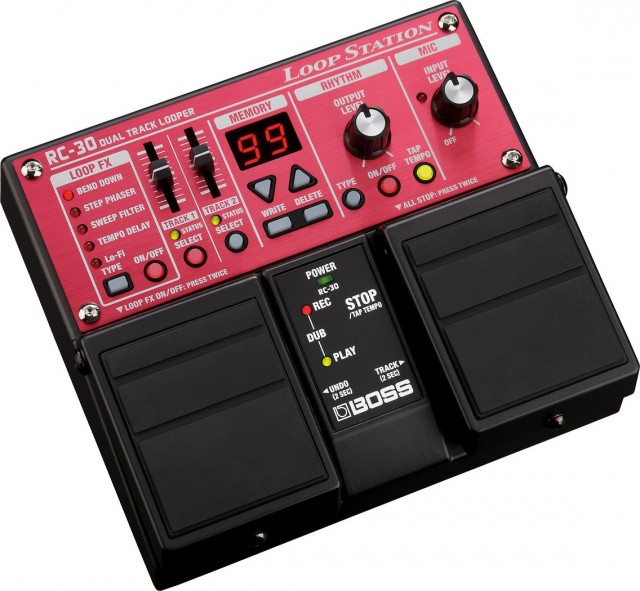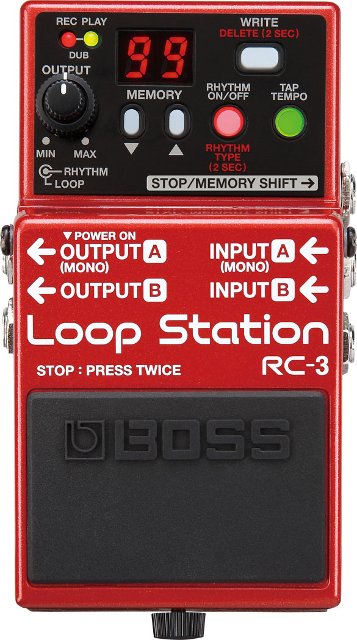You might not see it on a magazine cover or tattooed to someone’s arm, but the lowly looper is one of those things many musicians find invaluable. And in hardware loopers, the BOSS Loop Station reigns supreme – I’ve even seen a San Francisco-based musical act who call themselves LOOP ! STATION.
Believe it or not, the (actual) Loop Station hardware from BOSS has just turned ten. In one of the more overlooked hardware announcements this week, BOSS has rolled out some significant and promising-looking upgrades to these well-loved, affordable tools. There’s a new RC-3 stereo stompbox-style model, as well as an updated “dual track” model, the RC-30. (That lets you run two stereo tracks at once. No question, the RC-30 would be the one I’d get; it’s still reasonably portable, and having two tracks means geometrically more musical options in my opinion. But I can see the appeal of the RC-3 being small and stompbox-like.)
One weird thing about hardware is that it’s tended not to keep pace with storage capacity in computers and mobile devices. That’s not the case here – both models, even including that little stompbox, can record up to three hours in stereo. I’m not quite sure what people will use that storage capacity for – stompbox version of Erik Satie’s Vexations, perhaps?* But it’s nice to know it’s there.
How do these models compare to the previous models, and to competitors?
- More processing power (a six-fold improvement)
- Aforementioned three hours of stereo recording. (Seriously, you’d probably use that for more loops – up to 99 phrases – not one really long loop.)
- True stereo recording.
- Auto-quantize, which Roland’s Amanda Whiting describes as “forgiving looping.”
- Tempo-synced effects on the RC-30.
- USB 2.0 for import/export of audio, making this a foot-operated mobile workstation of sorts. (Try that with an iPhone or iPad. Actually, really, don’t – just had visions of broken glass and bloody feet.)
- Battery-powered for extra mobility.
If stompbox is what you want, Roland tells us the RC-3 is substantially easier to use. (Any RC-2 users who can tell us what they might mean?)
Check out the shot below of the back of the RC-30, too – it’s nice seeing a proper XLR jack on this kind of device and not just 1/4″; it’s even got phantom power. That makes this practical for acoustic instrumentalists and vocalists who might otherwise ignore this sort of gear.
There’s more to talk about – see additional specs below — but I was already sold on the Loop Station. Having a better Loop Station is just icing. Having talked to many, many musicians, it’s a perennial favorite among everyone from fairly large stars to obscure Game Boy artists. Roland’s Amanda Whiting is quick to tell CDM that competing loop pedals are limited to around half an hour of mono-only recording with no mic jack, but I’m guessing part of the reason I’ve never heard anyone using one of the competitors is that people found that out already.
The real rival: While it’s not a stompbox (no pedals) and therefore is a bit apples-to-oranges, the one competitor I think worth mentioning (and thanks to readers for chiming in) is Electro-Harmonix 2880. It’s the one box that can take on BOSS, provided your hands are free: it’s stereo like a BOSS, it’s got loads of storage like a BOSS (1GB card now), and it has USB connections like the BOSS. While I think it’s not as friendly or accessible as the BOSS may be, it has some advantages in other respects: there’s four-channel recording instead of two for some really advanced looping, and it has the one key feature missing on the Loop Station – MIDI sync. It’s a shame BOSS missed the opportunity to add a MIDI IN, at least on the RC-30. EH is actually here in NYC, and they assemble their gear right here, too, which almost no one does. (In the five boroughs, no less. It’s one of the only things Queens manufactures that’s not a doughnut or other pastry item.) So expect to see more of that EH, ideally close to the source.
RC-3 Loop Station
- 99 phrase memory
- Records to 44.1 kHz WAV, stereo.
- USB Mass Storage class compliant for file transfer. (Actually, here’s a twist: that means you can transfer files from this to an iPad, using the Camera Connection Kit. Or a computer, if you prefer.)
- Tap tempo, and/or play a “guide” rhythm with built-in percussion sounds.
- 1/4″ in (stereo pair), 1/4″ out (stereo pair), plus an aux stereo minijack. (Can’t be used simultaneously, but handy.)
- 9V power; use an alkaline or buy an adapter separately if you want a wall wart. 3 hour expected battery life.
RC-30 Dual Track Looper
The RC-30 has what the RC-3 does, but with some extra goodies:
- 2 track stereo recording.
- Effects: “BEND DOWN, STEP PHASER, SWEEP
FILTER, TEMPO DELAY, LO-FI.” It also boasts indicators so you can see what those effects are doing. (Sorry, Daleks. No Ring Mod, apparently.) - XLR mic input with a dedicated level knob.
- 48V phantom power.
- 7.5 hour expected alkaline battery life. (Longer than the RC-3, because you can add more batteries. Did I mention that I would recommend the RC-30?)
The RC-30 even has that handy aux jack for an 1/8″ stereo – another use for your iPad, or your Game Boy, or your Teenage Engineering OP-1.
I’ll try to get an RC-30 in for review, but I’d be curious how you’d review it. Let us know.
*Vexations, by astonishing coincidence, neatly sums up how I felt browsing hotel rooms in Anaheim a few weeks ago. I can stick my head under a fluorescent light, play my BBC sound effects CD cue for crowd noise, and hoarsely shout a press release. It’s just like being there. Oh, and yes, I’m a classical music nerd, too. Bring it.


